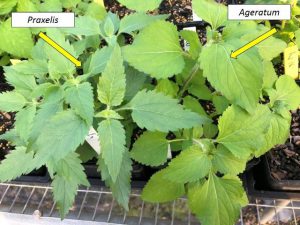Last Updated on September 2, 2020 by Yuvraj
Welcome to Weed Science Wednesday, a weekly series aimed at helping homeowners and horticulture professionals better identify and manage common landscape weeds in Florida.

Credit: Annette Chandler, UF/IFAS
The weed of the week is Praxelis (Praxelis clematidea). Praxelis is a newly emerging weed species in Florida. It was first discovered in an abandoned orange grove in Orange County, Florida, in 2006. Since then, it has been documented in seven central Florida counties (Hardee, Hillsborough, Lake, Manatee, Orange, Osceola, and Polk). Praxelis is native to Argentina, Bolivia, southern Brazil, and some other parts of South America. It is considered highly invasive in Queensland, Australia, and consequently was placed on an alert list for invasive plants in Australia. This species is thought to have been introduced into Florida as a contaminant in the commercial trade of seeds or possibly landscaping products, such as mulch and building materials. Plant Protection and Quarantine (PPQ) is considering adding praxelis to the federal noxious weed list. But it is currently listed on the USDA APHIS Not Authorized Pending Pest Risk Analysis list as a potential pest plant.
Praxelis grows in tropical and subtropical areas and tolerates partial to full sun or shade. It is an upright-growing herb that commonly grows to a height of 16–20 inches. The plant can be easily misidentified and confused with Ageratum houstonianum (bluemink) and Conoclinium coelestinum (blue mistflower) as well as several other species that have similar flower characteristics.

Credit: Chris Marble, UF/IFAS
The stem of praxelis is cylindrical, brittle, green in color, and covered in hair (pubescence). The leaves are hairy underneath, oppositely arranged, and ranges from a tear to a diamond shape. One of the distinguishing features of praxelis is the smell of its leaves, which emit a foul odor like cat urine when crushed or after mowing. It has lavender- or bluish-colored flowers that are in clusters of about 35–40 tubular florets (tiny flowers) growing in groups at the ends of hairy stems. Flowering mostly occurs from January to May, but plants have been observed flowering throughout the year in central Florida when winter temperatures remain mild.

Credit: Annette Chandler, UF/IFAS
For more information on Chickweed, including specific recommendations for chemical, physical and cultural weed controls, please consult: Biology and Management of Praxelis (Praxelis clematidea) in Ornamental Crop Production
 2
2
